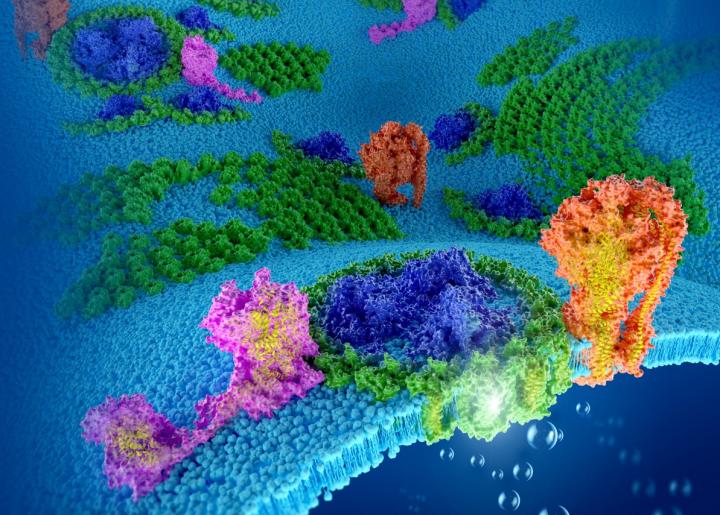Uncovering the architecture of natural photosynthetic machinery

Illustration of the cyanobacterial thylakoid membrane. Credit: Zhao, L., Huokko, T., Wilson, S. et al.
Researchers at the University of Liverpool have uncovered the molecular architecture and organisational landscape of thylakoid membranes from a model cyanobacterium in unprecedented detail.
The study, which is published in Nature Plants, could help researchers find new and improved artificial photosynthetic technologies for energy production.
Professor Luning Liu, who led the study, explained: “Cyanobacteria perform plant-like photosynthesis. Hence, thylakoid membranes from laboratory-grown cyanobacteria are the ideal model system for studying and tuning plant photosynthesis.”
The researchers used state-of-the-art atomic force microscopy (AFM) to probe the structures and organisation of photosynthetic proteins within the thylakoid membranes. The results reveal how thylakoid membranes modulate the abundance of different photosynthetic proteins and form structurally variable complexes to adapt to the changing environments.
Dr Longsheng Zhao, the first author of this paper, said: “We observed that different protein complexes have their specific locations in the thylakoid membranes. We also visualised that distinct photosynthetic complexes can be close to each other, indicating that these photosynthetic complexes can form 'supercomplex' structures to facilitate electron transport between these protein complexes.”
Professor Luning Liu, added: “The development of structural biology approaches has greatly improved our understanding of individual photosynthetic complexes. However, these techniques have limitations for studying membrane multi-protein assembly and interactions in their native membrane environment. Our research has proved the power and potential of AFM in exploring complex, dynamic membrane structures and transient protein assembly.”
The researchers hope their ongoing work could help find solutions to modulate the photosynthetic efficiency of crop plants to boost plant growth and productivity.
###
The project was done in collaboration with the University's Centre for Cell Imaging and researchers from Queen Mary University of London, Shandong University (China), Ocean University of China and Henan University (China). The research at the Liu lab was funded by the BBSRC and the Royal Society.
Media Contact
More Information:
http://dx.doi.org/10.1038/s41477-020-0694-3All latest news from the category: Life Sciences and Chemistry
Articles and reports from the Life Sciences and chemistry area deal with applied and basic research into modern biology, chemistry and human medicine.
Valuable information can be found on a range of life sciences fields including bacteriology, biochemistry, bionics, bioinformatics, biophysics, biotechnology, genetics, geobotany, human biology, marine biology, microbiology, molecular biology, cellular biology, zoology, bioinorganic chemistry, microchemistry and environmental chemistry.
Newest articles

A universal framework for spatial biology
SpatialData is a freely accessible tool to unify and integrate data from different omics technologies accounting for spatial information, which can provide holistic insights into health and disease. Biological processes…

How complex biological processes arise
A $20 million grant from the U.S. National Science Foundation (NSF) will support the establishment and operation of the National Synthesis Center for Emergence in the Molecular and Cellular Sciences (NCEMS) at…

Airborne single-photon lidar system achieves high-resolution 3D imaging
Compact, low-power system opens doors for photon-efficient drone and satellite-based environmental monitoring and mapping. Researchers have developed a compact and lightweight single-photon airborne lidar system that can acquire high-resolution 3D…





















